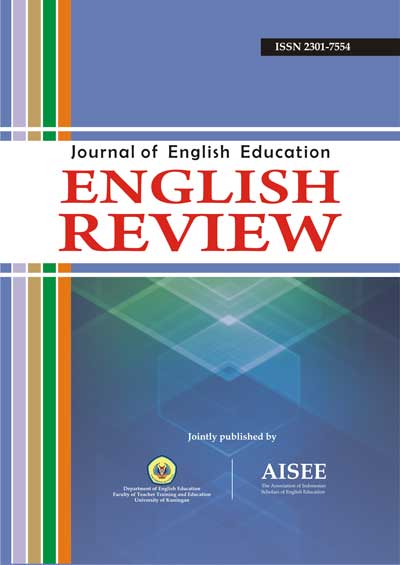A SELF-ASSESSMENT MODEL IN TEACHING ACADEMIC WRITING FOR INDONESIAN EFL LEARNERS
Abstract
Abstract: This self-assessment model is developed to help EFL students improve their achievement in academic writing, more particularly essay writing. In English department of Pancasakti University Tegal, academic writing is the course subject which develops models and practices of essay writing in order that students are actively engaged in rhetorical problem-solving. The development of this self-assessment model was derived from the analysis of both theoretical and empirical studies of self-assessment in EFL writing. The self-assessment model developed in this study consists of four kinds of self-assessment instruments: self-edit checklist of writing dimensions (CWD), checklist of writing strategies (CWS), survey questionnaire of writing interest and awareness (SWIA), and questionnaire of learning monitoring strategies (QLMS). This self-assessment model can be an alternative model in teaching academic writing to EFL students at university level, more particularly the students of English Department, Pancasakti University Tegal.
Keywords: self-assessment model, academic writing, Indonesian EFL learnersReferences
Birjandi P, (2010). The role of self-assessment in promoting Iranian EFL learners’ motivation. ELT Journal, 3(3).
Blanche, P. & Merino, B. J., (1989). Self assessment of foreign language skills: Implications for teachers and researchers. Language Learning, 39. 313-340.
Bloxam S, & Boyd P, (2007). Developing effective assessment in higher education: A practical guide. London: McGraw Hill-Open University Press
Boud, D. (1995). Enhancing learning through self assessment. London: Kogan Page).
Brown, H. D. (2004). Language assessment principles and classroom practices. New York: Pearson Education, Inc.
Cohen L., Manion L., Morisson, K. (2000). Research methods in education; 5th edition. New York: RoeutledgeFalmer.
Dyke, M. (2006). The role of the ‘Other’ in reflection, knowledge formation and action in a late modernity. International Journal of Lifelong Education, 25(2), 105-123.
Eleonora P., & Louca. (2008). Metacognition and theory of mind. Newcastle: Cambridge Scholars Publishing.
Ertmer, P. A., & Newby, T. J. (1996). The expert learner: Strategic, self-regulated and reflective. Instructional science, 24, 1-24.
Ferris, D. (1995). Teaching students to self-edit. TESOL Journal, 4(4), 18-22.
Flavell, John, H. 1979. Metacognition and cognitive monitoring. American Psychologist, 34(10), 906-911.
Harmer, J., (2004). How to teach writing. Essex: Pearson Education Limited
Illes, E. (2012). Learner autonomy revisited. ELT Journal, 66(4), 505-513
O’Malley and Pierce J.M., Pierce,V., (1996). Authentic Assessment for English Language Learners. Longman.
Orsmond, P., Merry, S., & Reiling, K. (2000). The use of student derived marking criteria in peer and self-assessment. Assessment and Evaluation in Higher Education, 25(1), 23–38.
Oscarson, A. D. (2009). Self-assessment of writing in learning English as a foreign language: A study at the upper secondary school level. Göteborg: Geson Hylte Tryck.
Oscarson, M. (1989). Self-assessment of language proficiency: Rationale and applications. Language Testing, 6(1), 1-13.
Oshima A., & Hogue A., (2006). Writing academic English. Pearson: Longman.
Sadek, N. (2011). The power of self-assessment in language learning. LAP Lambert Academic Publishing.
Seow, A. (2002). The writing process and process writing. In Jack C. Richards, Willy A. Renandya (Eds.) Methodology in language teaching: An anthology of current practice (pp.315-320). Cambridge, New York: Cambridge University Press
Taras, M. (2001). The use of tutor feedback and student self-assessment insummative assessment tasks: Towards transparency for students and for tutors. Assessment & Evaluation in Higher Education, 26(6), 289–306.
Wang, H., & Wang, Y. (2007). The Addition of an Affect Test and Self-assessment into ESL Writing Assessment: Process and Effect. Asian EFL Journal, 20.
Weigle (2000). Assessing writing. Cambridge: Cambridge University Press.
All articles published in English Review: Journal of English Education (ERJEE) are licensed under the Creative Commons Attribution 4.0 International License (CC BY 4.0).
Copyright Ownership
Authors retain the copyright of their articles and grant ERJEE the right of first publication. The journal is granted a non-exclusive license to publish, reproduce, and distribute the article in any format, medium, or platform, provided that proper credit is given to the original authors.
License Terms – CC BY 4.0
Under the Creative Commons Attribution 4.0 International License, others are free to:
- Share — copy and redistribute the material in any medium or format
- Adapt — remix, transform, and build upon the material for any purpose, even commercially
As long as they:
- Provide appropriate credit to the original author(s) and source
- Provide a link to the license (https://creativecommons.org/licenses/by/4.0/)
- Indicate if any changes were made
There are no restrictions on the reuse, reproduction, or adaptation of published articles as long as attribution is properly given.
Author Warranties
By submitting a manuscript to ERJEE, authors confirm that:
- The work is original and does not infringe any existing copyright.
- The manuscript has not been previously published and is not under consideration elsewhere.
- All sources and references are appropriately acknowledged.
- Necessary permissions have been obtained for any copyrighted materials used.










